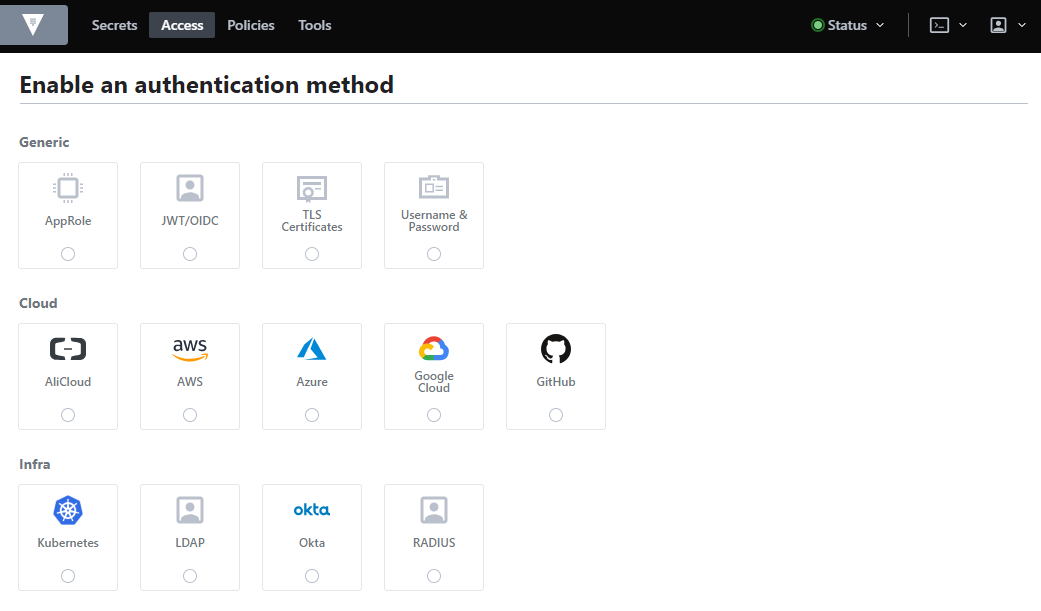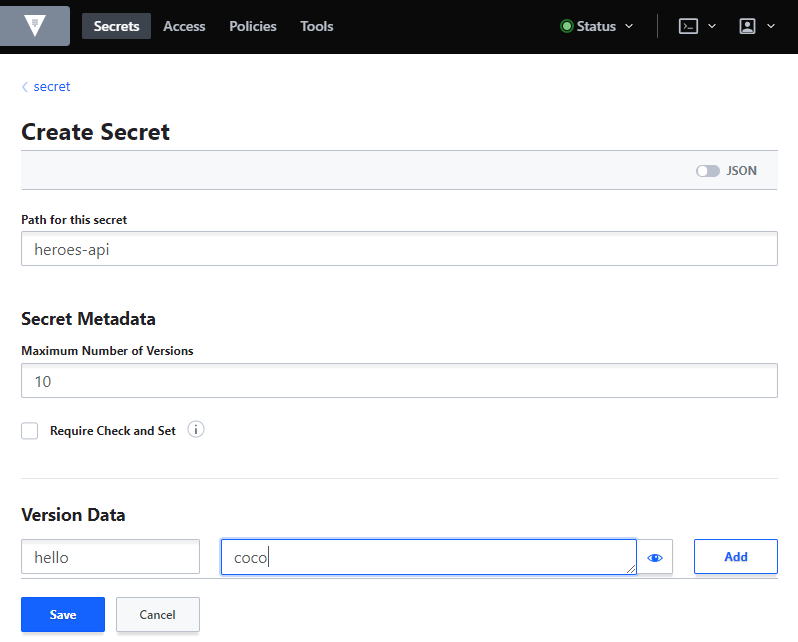项目中敏感配置信息一般需要进行加密处理,比如数据库密码,Spring Boot内置不提供加密支持,不能加密配置文件信息,在官方文档中提供了自定义Environment和Spring Cloud Vault两种解决方案。使用jasypt-spring-boot是另一种方案。
Spring Cloud Vault为HashiCorp Vault的客户端,支持访问HashiCorp Vault内存储的数据,避免了在Spring Boot程序中存储敏感数据。
本文详细介绍了jasypt-spring-boot、Spring Cloud Vault和HashiCorp Vault的使用。
自定义Environment
- 自己实现加解密的方法,在配置文件中使用密文,比如:
spring:
datasource:
password: a3Ehaf0f/S1Rt6JfOGfQ+w==
jwt:
secret: a3Ehaf0f/S1Rt6JfOGfQ+w==- 实现EnvironmentPostProcessor,在其中执行解密操作,简单示例如下:
package org.itrunner.heroes.config;
import org.springframework.boot.SpringApplication;
import org.springframework.boot.env.EnvironmentPostProcessor;
import org.springframework.boot.env.OriginTrackedMapPropertySource;
import org.springframework.boot.env.YamlPropertySourceLoader;
import org.springframework.core.env.ConfigurableEnvironment;
import org.springframework.core.env.MapPropertySource;
import org.springframework.core.env.PropertySource;
import org.springframework.core.io.ClassPathResource;
import org.springframework.core.io.Resource;
import java.io.IOException;
import java.util.Map;
public class DecryptedEnvironmentPostProcessor implements EnvironmentPostProcessor {
private final YamlPropertySourceLoader loader = new YamlPropertySourceLoader();
@Override
public void postProcessEnvironment(ConfigurableEnvironment environment, SpringApplication application) {
Resource path = new ClassPathResource("config.yml");
PropertySource<Map<String, Object>> propertySource = loadYaml(path);
environment.getPropertySources().addLast(propertySource);
}
private PropertySource<Map<String, Object>> loadYaml(Resource path) {
if (!path.exists()) {
throw new IllegalArgumentException("Resource " + path + " does not exist");
}
try {
OriginTrackedMapPropertySource propertySource = (OriginTrackedMapPropertySource) loader.load("custom-resource", path).get(0);
return new DecryptedMapPropertySource(propertySource);
} catch (IOException ex) {
throw new IllegalStateException("Failed to load yaml configuration from " + path, ex);
}
}
private static class DecryptedMapPropertySource extends MapPropertySource {
public DecryptedMapPropertySource(OriginTrackedMapPropertySource propertySource) {
super(propertySource.getName(), propertySource.getSource());
}
@Override
public Object getProperty(String name) {
Object value = super.getProperty(name);
if (value instanceof CharSequence) {
// 执行解密,返回明文
return "DecryptedValue";
}
return value;
}
}
}自定义的EnvironmentPostProcessor需在META-INF/spring.factories内注册:
org.springframework.boot.env.EnvironmentPostProcessor=org.itrunner.heroes.config.DecryptedEnvironmentPostProcessorJasypt Spring Boot
集成jasypt-spring-boot
有三种方式集成jasypt-spring-boot:
- 项目中如使用了@SpringBootApplication或@EnableAutoConfiguration,简单地添加jasypt-spring-boot-starter到classpath将在整个Spring环境中启用加密属性
<dependency>
<groupId>com.github.ulisesbocchio</groupId>
<artifactId>jasypt-spring-boot-starter</artifactId>
<version>2.1.0</version>
</dependency>- 添加jasypt-spring-boot到classpath,添加@EnableEncryptableProperties到main Configuration class将在整个Spring环境中启用加密属性
<dependency>
<groupId>com.github.ulisesbocchio</groupId>
<artifactId>jasypt-spring-boot</artifactId>
<version>2.1.0</version>
</dependency>@Configuration
@EnableEncryptableProperties
public class MyApplication {
...
}- 添加jasypt-spring-boot到classpath,使用@EncrytablePropertySource声明加密的属性或YAML文件
@Configuration
@EncryptablePropertySource(name = "EncryptedProperties", value = "classpath:encrypted.properties")
public class MyApplication {
...
}或者使用@EncryptablePropertySources:
@Configuration
@EncryptablePropertySources({@EncryptablePropertySource("classpath:encrypted.properties"),
@EncryptablePropertySource("file:/path/to/encrypted2.properties")})
public class MyApplication {
....
}加密配置
| Key | Required | Default Value |
|---|---|---|
| jasypt.encryptor.password | True | - |
| jasypt.encryptor.algorithm | False | PBEWithMD5AndDES |
| jasypt.encryptor.bean | False | jasyptStringEncryptor |
| jasypt.encryptor.keyObtentionIterations | False | 1000 |
| jasypt.encryptor.poolSize | False | 1 |
| jasypt.encryptor.providerName | False | null |
| jasypt.encryptor.saltGeneratorClassname | False | org.jasypt.salt.RandomSaltGenerator |
| jasypt.encryptor.stringOutputType | False | base64 |
| jasypt.encryptor.proxyPropertySources | False | false |
| jasypt.encryptor.property.prefix | False | ENC( |
| jasypt.encryptor.property.suffix | False | ) |
默认,加密算法为PBEWithMD5AndDES,加解密bean name为jasyptStringEncryptor,加密的数据需使用ENC()包裹。
所有这些属性都可在配置文件中声明,但加密密码不应存储在配置文件中,而应使用系统属性、命令行参数传入,只要名称为jasypt.encryptor.password即可:
java -jar jasypt-spring-boot-demo.jar --jasypt.encryptor.password=password
或
java -Djasypt.encryptor.password=password -jar jasypt-spring-boot-demo.jar也可在application.properties 或 application.yml中使用环境变量:
jasypt.encryptor.password=${JASYPT_ENCRYPTOR_PASSWORD:}配置文件示例:
spring:
jpa:
database-platform: org.hibernate.dialect.PostgreSQLDialect
hibernate:
ddl-auto: update
properties:
hibernate:
default_schema: heroes
format_sql: true
jdbc:
lob:
non_contextual_creation: true
show-sql: true
datasource:
platform: postgresql
driver-class-name: org.postgresql.Driver
url: jdbc:postgresql://localhost:5432/postgres
username: hero
password: ENC(a3Ehaf0f/S1Rt6JfOGfQ+w==)
initialization-mode: never
jasypt:
encryptor:
algorithm: PBEWithMD5AndDES
password: 1qefhQH7mRR4LADVettR
stringOutputType: base64
property:
prefix: ENC(
suffix: )生成加密数据
使用CLI工具JasyptPBEStringEncryptionCLI生成加密数据,如下:
java -cp jasypt-1.9.2.jar org.jasypt.intf.cli.JasyptPBEStringEncryptionCLI input="inputdata" password=secretkey algorithm=PBEWithMD5AndDES执行后,输出如下:
----ENVIRONMENT-----------------
Runtime: Oracle Corporation Java HotSpot(TM) 64-Bit Server VM 25.191-b12
----ARGUMENTS-------------------
algorithm: PBEWithMD5AndDES
input: hero
password: 1qefhQH7mRR4LADVettR
----OUTPUT----------------------
a3Ehaf0f/S1Rt6JfOGfQ+w==生成后,使用ENC(密文)替换明文数据即可。
HashiCorp Vault
HashiCorp Vault提供集中管理机密(Secret)和保护敏感数据的服务,可通过UI、CLI或HTTP API访问。HashiCorp Vault使用GO语言编写。
初识HashiCorp Vault
- 安装HashiCorp Vault
根据您的系统下载HashiCorp Vault,然后解压zip包,其中为一可执行文件。
以linux系统为例:
$ unzip vault_1.0.2_linux_amd64.zip
$ sudo chown root:root vault
$ sudo chmod 755 vault
$ sudo mv vault /usr/local/bin/
$ vault --version帮助
直接运行vault可查看支持的命令:
$ vault
Usage: vault <command> [args]
Common commands:
read Read data and retrieves secrets
write Write data, configuration, and secrets
delete Delete secrets and configuration
list List data or secrets
login Authenticate locally
agent Start a Vault agent
server Start a Vault server
status Print seal and HA status
unwrap Unwrap a wrapped secret
Other commands:
audit Interact with audit devices
auth Interact with auth methods
kv Interact with Vault's Key-Value storage
lease Interact with leases
namespace Interact with namespaces
operator Perform operator-specific tasks
path-help Retrieve API help for paths
plugin Interact with Vault plugins and catalog
policy Interact with policies
secrets Interact with secrets engines
ssh Initiate an SSH session
token Interact with tokens
运行 vault [command] [subcommand] -h可查看命令支持的参数。
path-help 查看系统、Secret引擎、认证方法等路径支持的配置,在实际应用中经常用到。比如:
$ vault path-help sys/
$ vault path-help database/
$ vault path-help database/roles
$ vault path-help aws/
$ vault path-help auth/token/
$ vault path-help auth/aws/说明:要启用相应功能才能查看路径。
自动完成
linux下,Vault支持命令自动完成功能,安装后输入vault [tab]会显示命令提示,需执行以下命令安装:
$ vault -autocomplete-install
$ exec $SHELL安装后将在~/.bashrc内添加如下内容:
complete -C /usr/local/bin/vault vaultdev模式启动Vault
以dev模式启动不需任何配置,数据保存在内存中。
$ vault server -dev控制台输出如下内容:
==> Vault server configuration:
Api Address: http://127.0.0.1:8200
Cgo: disabled
Cluster Address: https://127.0.0.1:8201
Listener 1: tcp (addr: "127.0.0.1:8200", cluster address: "127.0.0.1:8201", max_request_duration: "1m30s", max_request_size: "33554432", tls: "disabled")
Log Level: (not set)
Mlock: supported: true, enabled: false
Storage: inmem
Version: Vault v1.0.1
Version Sha: 08df121c8b9adcc2b8fd55fc8506c3f9714c7e61
WARNING! dev mode is enabled! In this mode, Vault runs entirely in-memory
and starts unsealed with a single unseal key. The root token is already
authenticated to the CLI, so you can immediately begin using Vault.
You may need to set the following environment variable:
$ export VAULT_ADDR='http://127.0.0.1:8200'
The unseal key and root token are displayed below in case you want to
seal/unseal the Vault or re-authenticate.
Unseal Key: xSahEjtRQMMwbyBW6+rIzE2RRJ4d8X7BmAyPsSk63yE=
Root Token: s.5bnclu8POKx2WCxETB4u8RqF
Development mode should NOT be used in production installations!其中,Unseal Key、Root Token要保存下来。以dev模式启动Vault其状态是unseal的,不需要使用Unseal Key解封服务器。访问Vault需要使用Root Token。建议将Vault服务器地址保存到环境变量VAULT_ADDR中,否则使用命令行访问vault时需要指定-address参数。
查看Vault Server状态:
$ vault status -address=http://127.0.0.1:8200说明:-address默认为https://127.0.0.1:8200
- 登录Vault
从浏览器登录Vault,在地址栏输入http://localhost:8200 :
在Token文本框内输入“Root Token”,进入Vault主界面:
从命令行登录Vault:
$ vault login -method=token -address=http://127.0.0.1:8200
Token (will be hidden):
Success! You are now authenticated. The token information displayed below
is already stored in the token helper. You do NOT need to run "vault login"
again. Future Vault requests will automatically use this token.
Key Value
--- -----
token s.1Pv48heTmZhXjm0bBd84Muef
token_accessor 3gfMlTXFPHX3ehMQzkJUrk3o
token_duration ∞
token_renewable false
token_policies ["root"]
identity_policies []
policies ["root"]- 认证方法
Vault支持多种登录认证方式,默认启用了token方式。
从命令行查看启用的认证方法:
$ vault auth list
Path Type Accessor Description
---- ---- -------- -----------
token/ token auth_token_cd421269 token based credentials- Secret引擎
Vault支持多种Secret引擎,一些引擎只是存储和读取数据,如kv;一些引擎连接到其他服务并根据需要生成动态凭据,如AWS、database;一些引擎提供加密服务(如transit)、证书生成(如pki)等。默认启用了kv(Key-Value)和cubbyhole引擎。
从命令行查看启用的Secret引擎:
$ vault secrets list
Path Type Accessor Description
---- ---- -------- -----------
cubbyhole/ cubbyhole cubbyhole_835f8a75 per-token private secret storage
identity/ identity identity_0ba84c63 identity store
secret/ kv kv_9558dfb7 key/value secret storage
sys/ system system_5f7114e7 system endpoints used for control, policy and debugging我们在kv引擎secret下创建一secret供后面测试使用,如下:
也可以使用命令行:
$ vault kv put secret/heroes-api hello=coco查询secret:
$ vault kv get secret/heroes-api部署HashiCorp Vault
之前使用dev模式启动Vault,接下来说明真实环境如何配置。
- 配置Vault
以非dev模式启动Vault必须提供至少一个配置文件,下面创建配置文件vault.hcl:
$ sudo mkdir --parents /etc/vault.d
$ sudo touch /etc/vault.d/vault.hcl
$ sudo chown --recursive ec2-user:ec2-user /etc/vault.d
$ sudo chmod 640 /etc/vault.d/vault.hcl配置文件支持HCL (HashiCorp Configuration Language)和JSON格式,vault.hcl内容如下:
ui = true
storage "file" {
path = "/usr/vault/data"
}
listener "tcp" {
address = "0.0.0.0:8200"
tls_cert_file = "/etc/vault.d/cert.pem"
tls_key_file = "/etc/vault.d/privkey.pem"
}
api_addr = "https://10.188.12.119:8200"参数:
- ui 是否启用UI,默认为false
- storage 物理存储方式,支持以下的类型:azure、cassandra、cockroachdb、consul、couchdb、dynamodb、etcd、file、foundationdb、spanner、gcs、inmem、manta、mssql、mysql、postgresql、s3、swift、zookeeper
- listener 监听器,可以配置一个或多个
- api_addr 在集群环境中使用,指定向集群中的其他vault服务器公布的URL,以供客户端重定向。也可以通过环境变量VAULT_API_ADDR设定
生成自签名证书:
$ openssl genrsa -out privkey.pem
$ openssl req -x509 -new -key privkey.pem -out cert.pem -days 365 -subj /C=CN/ST=Beijing/L=Beijing/CN=vault.itrunner.org/OU=itrunner/O=itrunner/[email protected]使用自签名证书时需要配置环境变量VAULT_CACERT:
$ export VAULT_CACERT='/etc/vault.d/cert.pem'Spring Cloud Vault通过HTTPS协议访问Vault时需配置客户端证书,执行以下命令将cert.pem导入到keystore中:
$ keytool -importcert -keystore keystore.jks -file cert.pem -noprompt -storepass changeit -alias heroes- 测试启动Vault
启动前先授权vault使用mlock syscall:
$ sudo setcap cap_ipc_lock=+ep /usr/local/bin/vault否则会显示如下错误:
Error initializing core: Failed to lock memory: cannot allocate memory
This usually means that the mlock syscall is not available.
Vault uses mlock to prevent memory from being swapped to
disk. This requires root privileges as well as a machine
that supports mlock. Please enable mlock on your system or
disable Vault from using it. To disable Vault from using it,
set the `disable_mlock` configuration option in your configuration
file.启动Vault:
$ vault server -config=/etc/vault.d/vault.hcl- 配置Vault服务
kill掉上面的vault进程,配置vault为系统服务。
创建vault.service:
$ sudo touch /etc/systemd/system/vault.service内容如下:
[Unit]
Description="HashiCorp Vault - A tool for managing secrets"
Documentation=https://www.vaultproject.io/docs/
Requires=network-online.target
After=network-online.target
ConditionFileNotEmpty=/etc/vault.d/vault.hcl
[Service]
User=ec2-user
Group=ec2-user
SecureBits=keep-caps
AmbientCapabilities=CAP_IPC_LOCK
Capabilities=CAP_IPC_LOCK+ep
CapabilityBoundingSet=CAP_SYSLOG CAP_IPC_LOCK
ExecStart=/usr/local/bin/vault server -config=/etc/vault.d/vault.hcl
ExecReload=/bin/kill --signal HUP $MAINPID
KillMode=process
KillSignal=SIGINT
Restart=on-failure
RestartSec=5
TimeoutStopSec=30
StartLimitIntervalSec=60
StartLimitBurst=3
[Install]
WantedBy=multi-user.target启动Vault:
$ sudo systemctl enable vault
$ sudo systemctl start vault
$ sudo systemctl status vault- 初始化Vault
首次启动vault后需要执行初始化操作。
$ vault operator init初始化后生成加密key、unseal key、Initial Root Token,这些数据要保存到安全的地方。
Unseal Key 1: 1OlGbwCZ/y4IeULDGWdi1x3I4weOil8sWanlZ5M3gUN8
Unseal Key 2: LwILr0IuyKLwpooN8d7C6mQPr/AuzqzMq20RhKQlw8gR
Unseal Key 3: OMr0B1n4ugZErUWzwsoA3rFZw3v3nsJM5oQWocgr9SYo
Unseal Key 4: a1m2Wbz+tlv1e7cTsidXKa1Yt/DTbzaFJlza2s/khUau
Unseal Key 5: ZuL66Av5SOH9gYLii2VHec6CcWUktXk99qabWfcSAF9H
Initial Root Token: s.1Pv48heTmZhXjm0bBd84Muef
Vault initialized with 5 key shares and a key threshold of 3. Please securely
distribute the key shares printed above. When the Vault is re-sealed,
restarted, or stopped, you must supply at least 3 of these keys to unseal it
before it can start servicing requests.
Vault does not store the generated master key. Without at least 3 key to
reconstruct the master key, Vault will remain permanently sealed!
It is possible to generate new unseal keys, provided you have a quorum of
existing unseal keys shares. See "vault operator rekey" for more information.- Seal/Unseal
初始化后Vault Server处于封印状态,因不知如何解密存储的数据,所以不能读取。初始化输出的内容中“Vault initialized with 5 key shares and a key threshold of 3”,意味着为了解封需要5个key中的3个,执行解封命令如下:
$ vault operator unseal选取3个key,执行3次上面的命令直到Sealed状态为false:
Unseal Key (will be hidden):
Key Value
--- -----
Seal Type shamir
Initialized true
Sealed false
Total Shares 5
Threshold 3
Version 1.0.1
Cluster Name vault-cluster-654a8704
Cluster ID 91e5ea90-1a78-45c8-36f6-99a0ba7b5eec
HA Enabled false- 登录Vault
使用Initial Root Token登录Vault:
$ vault login s.1Pv48heTmZhXjm0bBd84Muef登录成功后,输出如下结果:
Success! You are now authenticated. The token information displayed below
is already stored in the token helper. You do NOT need to run "vault login"
again. Future Vault requests will automatically use this token.
Key Value
--- -----
token s.1Pv48heTmZhXjm0bBd84Muef
token_accessor 3gfMlTXFPHX3ehMQzkJUrk3o
token_duration ∞
token_renewable false
token_policies ["root"]
identity_policies []
policies ["root"]root用户可以重新封印Vault:
$ vault operator sealVault支持集群部署,更多内容请查阅官方文档。
Token和Policy管理
Root Token具有最高权限,最佳实践不应存储Root Token,仅在必要时使用vault operator generate-root命令生成,用毕撤销token。
撤销token
$ vault token revoke -self生成Root Token
- 初始化Root Token,生成one-time password (OTP)、Nonce
$ vault operator generate-root -init
A One-Time-Password has been generated for you and is shown in the OTP field.
You will need this value to decode the resulting root token, so keep it safe.
Nonce 94e81220-dc59-16c5-1f08-180551cfa158
Started true
Progress 0/3
Complete false
OTP kVpqIjLf7BZQgNUbEBAuQPikRk
OTP Length 26- 生成Root Token
$ vault operator generate-root
Operation nonce: 94e81220-dc59-16c5-1f08-180551cfa158
Unseal Key (will be hidden):
Nonce 94e81220-dc59-16c5-1f08-180551cfa158
Started true
Progress 1/3
Complete false需要输入3次Unseal Key,成功后将输出Encoded Token:
Encoded Token GHhHHBovfg9dEQAiASNhFiEFMT0DOjw+Gx4- 解码Token
$ vault operator generate-root -decode=GHhHHBovfg9dEQAiASNhFiEFMT0DOjw+Gx4 -otp=kVpqIjLf7BZQgNUbEBAuQPikRk创建Token,设定有效时间,不指定policy
$ vault token create -ttl 10m
Key Value
--- -----
token s.8DibgV8wlTJq3ygtcfK4ne2K
token_accessor NuElYtSnxF51JXli3LC6XKHM
token_duration 10m
token_renewable true
token_policies ["root"]
identity_policies []
policies ["root"]新token为当前使用token的子token,权限继承自当前使用的token。
过期后可renew token:
vault token renew s.8DibgV8wlTJq3ygtcfK4ne2K创建Token,指定Policy
Policy有如下几种权限:
# This section grants all access on "secret/*". Further restrictions can be
# applied to this broad policy, as shown below.
path "secret/*" {
capabilities = ["create", "read", "update", "delete", "list"]
}
# Even though we allowed secret/*, this line explicitly denies
# secret/super-secret. This takes precedence.
path "secret/super-secret" {
capabilities = ["deny"]
}创建策略文件,仅允许读取路径secret/heroes-api:
$ vi heroes-policy.hcl内容如下:
path "secret/heroes-api" {
capabilities = ["read"]
}上传策略:
$ vault policy write heroes heroes-policy.hcl使用新策略创建Token:
$ vault token create -policy=heroes
Key Value
--- -----
token s.1bJDHR7VuSaHfquqmoQREioA
token_accessor FGufmiTSqWcEaiZAg9nuLkvx
token_duration 768h
token_renewable true
token_policies ["default" "heroes"]
identity_policies []
policies ["default" "heroes"]默认duration为768h,policy为"default" "heroes"。
使用新token登录,查看secret:
$ vault login s.1bJDHR7VuSaHfquqmoQREioA
$ vault kv get secret/heroes-apiAWS Secret引擎
使用AWS Secret引擎,每次访问创建新的AWS用户和登录凭证(访问密钥),Vault并不存储凭证。
- 启用AWS Secret引擎
$ vault secrets enable aws
Success! Enabled the aws secrets engine at: aws/- 配置AWS账户
$ vault write aws/config/root access_key=VKIAJBRHKH6EVTTNXDHA secret_key=vCtSM8ZUEQ3mOFVlYPBQkf2sO6F/W7a5TVzrl3Oj region=cn-north-1
Success! Data written to: aws/config/root说明,可使用vault path-help命令查看路径配置:
$ vault path-help aws/- 创建Role
配置Vault创建的AWS用户的角色:
$ vault write aws/roles/my-role \
credential_type=iam_user \
policy_document=-<<EOF
{
"Version": "2012-10-17",
"Statement": [
{
"Sid": "Stmt1426528957000",
"Effect": "Allow",
"Action": [
"ec2:*"
],
"Resource": [
"*"
]
}
]
}
EOF
Success! Data written to: aws/roles/my-role- 生成密钥
$ vault read aws/creds/my-role
Key Value
--- -----
lease_id aws/creds/my-role/0bce0782-32aa-25ec-f61d-c026ff22106e
lease_duration 768h
lease_renewable true
access_key VKIAJBRHKH6EVTTNXDHA
secret_key vCtSM8ZUEQ3mOFVlYPBQkf2sO6F/W7a5TVzrl3Oj
security_token <nil>成功执行以上命令后可通过AWS IAM控制台查看新创建的用户。
- renew和revoke
可使用lease_id来执行renew、revoke操作,执行revoke后将删除AWS用户:
$ vault lease revoke aws/creds/my-role/0bce0782-32aa-25ec-f61d-c026ff22106Database Secret引擎
使用Database Secret引擎可动态创建数据库用户并授权。目前支持的数据库有Cassandra、HANA、MongoDB、MSSQL、MySQL/MariaDB、PostgreSQL、Oracle。
- 启用Database Secret引擎
$ vault secrets enable database- 配置数据库插件和连接URL
$ vault write database/config/my-postgresql-database plugin_name=postgresql-database-plugin allowed_roles="my-role" \
connection_url="postgresql://{{username}}:{{password}}@localhost:5432?sslmode=disable" \
username="postgres" password="postgres"参数:
plugin_name 插件名称,使用postgresql数据库
allowed_roles 允许使用的vault角色
用户名、密码要使用模板。
可执行以下命令查看参数说明:
$ vault path-help database/config/my-postgresql-database- 创建角色
角色用来定义创建数据库用户和授权的脚本:
$ vault write database/roles/my-role db_name=my-postgresql-database \
creation_statements="CREATE ROLE \"{{name}}\" WITH LOGIN PASSWORD '{{password}}' VALID UNTIL '{{expiration}}'; \
GRANT SELECT ON ALL TABLES IN SCHEMA public TO \"{{name}}\";" \
default_ttl="1h" max_ttl="24h"
Success! Data written to: database/roles/my-role{{name}}和{{password}}将动态生成。
- 创建数据库用户
$ vault read database/creds/my-role
Key Value
--- -----
lease_id database/creds/my-role/789xpa9Rg3vVosLDMaTJKDnT
lease_duration 1h
lease_renewable true
password A1a-PLaakX5RdWS5Wb7t
username v-root-my-role-4sXjeClqaYXQF10lms8F-1547715152AWS认证
AWS认证方法提供了一种自动索取Vault token的机制,支持EC2和IAM两种方式。
EC2认证,AWS被视为受信任的第三方,使用唯一代表每个ec2实例的加密签名动态元数据信息进行身份验证,仅适用于EC2实例。
IAM认证,使用AWS IAM凭据签名的AWS请求进行身份验证,IAM凭据可来自IAM User、IAM Role,适用于EC2实例、Lambda函数及其他提供AWS凭据的环境。推荐使用IAM认证。
- 启用AWS认证
$ vault auth enable aws- 配置AWS账户和终端节点
根据您使用的AWS区域选择终端节点,AWS区域和终端节点。
$ vault write auth/aws/config/client access_key=VKIAJBRHKH6EVTTNXDHA secret_key=vCtSM8ZUEQ3mOFVlYPBQkf2sO6F/W7a5TVzrl3Oj \
endpoint=https://ec2.cn-north-1.amazonaws.com.cn iam_endpoint=https://iam.cn-north-1.amazonaws.com.cn \
sts_endpoint=https://sts.cn-north-1.amazonaws.com.cn \
iam_server_id_header_value=vault.itrunner.org- 配置角色策略
角色配置中至少含有一种约束条件。
EC2认证
$ vault write auth/aws/role/dev-role auth_type=ec2 bound_ami_id=ami-04f306762a9e9a056 policies=heroes max_ttl=768hIAM User认证
$ vault write auth/aws/role/dev-role-iam-user auth_type=iam bound_iam_principal_arn=arn:aws-cn:iam::123456789012:user/test policies=heroes max_ttl=768h登录时仅需提供User访问密钥。
IAM Role认证
下例适用于EC2实例,inferred_entity_type为ec2_instance,认证的EC2需要授予IAM角色并符合约束条件。
$ vault write auth/aws/role/dev-role-iam auth_type=iam inferred_entity_type=ec2_instance inferred_aws_region=cn-north-1 bound_ami_id=ami-04f306762a9e9a056 bound_iam_principal_arn=arn:aws-cn:iam::123456789012:role/MyRole policies=heroes max_ttl=768h- EC2认证登录
EC2认证需要验证签名,需要配置region的公有证书。
中国(北京)地区的 AWS 公有证书如下:
-----BEGIN CERTIFICATE-----
MIIDNjCCAh4CCQD3yZ1w1AVkTzANBgkqhkiG9w0BAQsFADBcMQswCQYDVQQGEwJV
UzEZMBcGA1UECBMQV2FzaGluZ3RvbiBTdGF0ZTEQMA4GA1UEBxMHU2VhdHRsZTEg
MB4GA1UEChMXQW1hem9uIFdlYiBTZXJ2aWNlcyBMTEMwIBcNMTUwNTEzMDk1OTE1
WhgPMjE5NDEwMTYwOTU5MTVaMFwxCzAJBgNVBAYTAlVTMRkwFwYDVQQIExBXYXNo
aW5ndG9uIFN0YXRlMRAwDgYDVQQHEwdTZWF0dGxlMSAwHgYDVQQKExdBbWF6b24g
V2ViIFNlcnZpY2VzIExMQzCCASIwDQYJKoZIhvcNAQEBBQADggEPADCCAQoCggEB
AMWk9vyppSmDU3AxZ2Cy2bvKeK3F1UqNpMuyeriizi+NTsZ8tQqtNloaQcqhto/l
gsw9+QSnEJeYWnmivJWOBdn9CyDpN7cpHVmeGgNJL2fvImWyWe2f2Kq/BL9l7N7C
P2ZT52/sH9orlck1n2zO8xPi7MItgPHQwu3OxsGQsAdWucdxjHGtdchulpo1uJ31
jsTAPKZ3p1/sxPXBBAgBMatPHhRBqhwHO/Twm4J3GmTLWN7oVDds4W3bPKQfnw3r
vtBj/SM4/IgQ3xJslFcl90TZbQbgxIi88R/gWTbs7GsyT2PzstU30yLdJhKfdZKz
/aIzraHvoDTWFaOdy0+OOaECAwEAATANBgkqhkiG9w0BAQsFAAOCAQEAdSzN2+0E
V1BfR3DPWJHWRf1b7zl+1X/ZseW2hYE5r6YxrLv+1VPf/L5I6kB7GEtqhZUqteY7
zAceoLrVu/7OynRyfQetJVGichaaxLNM3lcr6kcxOowb+WQQ84cwrB3keykH4gRX
KHB2rlWSxta+2panSEO1JX2q5jhcFP90rDOtZjlpYv57N/Z9iQ+dvQPJnChdq3BK
5pZlnIDnVVxqRike7BFy8tKyPj7HzoPEF5mh9Kfnn1YoSVu+61lMVv/qRjnyKfS9
c96nE98sYFj0ZVBzXw8Sq4Gh8FiVmFHbQp1peGC19idOUqxPxWsasWxQXO0azYsP
9RyWLHKxH1dMuA==
-----END CERTIFICATE-----将其保存在文件AWSpubkey中,然后执行下面命令导入证书:
$ vault write auth/aws/config/certificate/cn-cert aws_public_cert="$(cat AWSpubkey)"说明:cn-cert为证书名称。
首次EC2认证时执行如下命令:
$ vault write auth/aws/login role=dev-role \
pkcs7="$(curl -s http://169.254.169.254/latest/dynamic/instance-identity/pkcs7 | tr -d '\n')"输出如下结果:
Key Value
--- -----
token s.zVo29eIEkbdtpitFc3r5bjc3
token_accessor v1ZFeHEQyWidnCiLNLHs5lA7
token_duration 768h
token_renewable true
token_policies ["default" "heroes"]
identity_policies []
policies ["default" "heroes"]
token_meta_account_id 123456789012
token_meta_ami_id ami-03dc01372eae510e2
token_meta_instance_id i-015f7488c627dff71
token_meta_nonce dba47cd8-06ad-9de0-7fee-34b977409bc4
token_meta_region cn-north-1
token_meta_role dev-role
token_meta_role_tag_max_ttl 0s其中包含token、token_meta_nonce等,token权限为["default" "heroes"]。
再次登录时需要提供nonce:
$ vault write auth/aws/login role=dev-role \
pkcs7="$(curl -s http://169.254.169.254/latest/dynamic/instance-identity/pkcs7 | tr -d '\n')" \
nonce=dba47cd8-06ad-9de0-7fee-34b977409bc4- IAM认证登录
IAM认证,Vault使用了AWS GO SDK,需要指定AWS Region:
$ export AWS_REGION=cn-north-1也可以设置环境变量AWS_SDK_LOAD_CONFIG为true,这样可以从.aws文件夹读取配置:
$ export AWS_SDK_LOAD_CONFIG=true执行IAM User认证:
$ vault login -method=aws header_value=vault.itrunner.org role=dev-role-iam-user aws_access_key_id=ASIAIOSFODNN7EXAMPLE aws_secret_access_key=wJalrXUtnFEMI/K7MDENG/bPxRfiCYEXAMPLEKEY访问密钥可以在命令行提供,也可以从.aws文件夹读取。输出如下结果:
Success! You are now authenticated. The token information displayed below
is already stored in the token helper. You do NOT need to run "vault login"
again. Future Vault requests will automatically use this token.
Key Value
--- -----
token s.zVo29eIEkbdtpitFc3r5bjc3
token_accessor v1ZFeHEQyWidnCiLNLHs5lA7
token_duration 768h
token_renewable true
token_policies ["default" "heroes"]
identity_policies []
policies ["default" "heroes"]
token_meta_inferred_aws_region n/a
token_meta_inferred_entity_id n/a
token_meta_inferred_entity_type n/a
token_meta_account_id 123456789012
token_meta_auth_type iam
token_meta_canonical_arn arn:aws-cn:iam::123456789012:user/test
token_meta_client_arn arn:aws-cn:iam::123456789012:user/test
token_meta_client_user_id AROAPQVNYAPQTLNZVYUL9执行IAM Role认证:
$ vault login -method=aws header_value=vault.itrunner.org role=dev-role-iam输出如下结果:
Success! You are now authenticated. The token information displayed below
is already stored in the token helper. You do NOT need to run "vault login"
again. Future Vault requests will automatically use this token.
Key Value
--- -----
token s.zVo29eIEkbdtpitFc3r5bjc3
token_accessor v1ZFeHEQyWidnCiLNLHs5lA7
token_duration 768h
token_renewable true
token_policies ["default" "heroes"]
identity_policies []
policies ["default" "heroes"]
token_meta_inferred_aws_region cn-north-1
token_meta_inferred_entity_id i-0744e18eb21c22cc1
token_meta_inferred_entity_type ec2_instance
token_meta_account_id 123456789012
token_meta_auth_type iam
token_meta_canonical_arn arn:aws-cn:iam::123456789012:role/MyRole
token_meta_client_arn arn:aws-cn:sts::123456789012:assumed-role/MyRole/i-0744e18eb21c22cc1
token_meta_client_user_id AROAPQVNYAPQTLNZVYUL9若未指定AWS Region,会输出如下错误:
Error authenticating: Error making API request.
URL: PUT https://vault.itrunner.org:8200/v1/auth/aws/login
Code: 400. Errors:
* error making upstream request: received error code 403 from STS: <ErrorResponse xmlns="https://sts.amazonaws.com/doc/2011-06-15/">
<Error>
<Type>Sender</Type>
<Code>SignatureDoesNotMatch</Code>
<Message>Credential should be scoped to a valid region, not 'us-east-1'. </Message>
</Error>
<RequestId>82c67acf-2e8e-11e9-a251-03d652cb82bc</RequestId>
</ErrorResponse>Spring Cloud Vault
快速开始
- POM配置
在POM中配置Spring Cloud Vault依赖:
<dependencyManagement>
<dependencies>
<dependency>
<groupId>org.springframework.cloud</groupId>
<artifactId>spring-cloud-vault-dependencies</artifactId>
<version>2.1.0.RELEASE</version>
<scope>import</scope>
<type>pom</type>
</dependency>
</dependencies>
</dependencyManagement>
<dependencies>
<dependency>
<groupId>org.springframework.cloud</groupId>
<artifactId>spring-cloud-starter-vault-config</artifactId>
</dependency>
</dependencies>- bootstrap配置
Spring Cloud Vault配置支持bootstrap.properties、bootstrap.yml两种格式。在项目resources目录下创建bootstrap.yml文件,内容如下:
spring:
application:
name: heroes-api
cloud:
vault:
application-name: heroes-api
host: vault.itrunner.org
port: 8200
scheme: https
authentication: TOKEN
token: s.1Rkb4yNR5WYawHLcdpYxzrox
connection-timeout: 5000
read-timeout: 15000
config:
order: -10
ssl:
trust-store: classpath:keystore.jks
trust-store-password: changeit
kv:
enabled: true
backend: secret
profile-separator: /
default-context: application
application-name: heroes-api参数含义:
authentication: TOKEN 设置认证方式,Spring Cloud Vault支持的认证方式有:TOKEN, APPID, APPROLE, AWS_EC2, AWS_IAM, AZURE_MSI, CERT, CUBBYHOLE, GCP_GCE, GCP_IAM, KUBERNETES
kv.enabled: true 访问kv引擎数据
kv.backend: secret 设置secret的路径
Spring Cloud Vault从以下路径查找secret属性数据:
/secret/{application}/{profile}
/secret/{application}
/secret/{default-context}/{profile}
/secret/{default-context}application名字由以下配置属性决定:
spring.cloud.vault.kv.application-name
spring.cloud.vault.application-name
spring.application.name使用https协议时需配置trust-store。
- 访问在HashiCorp Vault中存储的值
访问方式与读取Spring Boot配置文件属性相同,以下代码则会读取/secret/heroes-api/hello值:
@Value("${hello}")
String name;AWS Secret后端
从HashiCorp Vault AWS Secret引擎获取凭证,需增加spring-cloud-vault-config-aws依赖:
<dependencies>
<dependency>
<groupId>org.springframework.cloud</groupId>
<artifactId>spring-cloud-vault-config-aws</artifactId>
<version>2.1.0.RELEASE</version>
</dependency>
</dependencies>增加如下配置启用AWS后端:
spring.cloud.vault:
aws:
enabled: true
role: my-role
backend: aws
access-key-property: cloud.aws.credentials.accessKey
secret-key-property: cloud.aws.credentials.secretKey参数:
role AWS Secret引擎中的角色名称
access-key-property 存储AWS access key的属性名称
secret-key-property 存储AWS secret key的属性名称
代码中读取生成用户凭证:
@Value("${cloud.aws.credentials.accessKey}")
String accessKey;
@Value("${cloud.aws.credentials.secretKey}")
String secretKey;每次读取创建AWS用户和访问密钥。
Database Secret后端
为利用Vault Database Secret引擎动态创建数据库凭证需添加spring-cloud-vault-config-databases依赖:
<dependencies>
<dependency>
<groupId>org.springframework.cloud</groupId>
<artifactId>spring-cloud-vault-config-databases</artifactId>
<version>2.1.0.RELEASE</version>
</dependency>
</dependencies>增加如下配置启用Database后端:
spring.cloud.vault:
database:
enabled: true
role: my-role
backend: database
username-property: spring.datasource.username
password-property: spring.datasource.password 参数:
role Database Secret引擎中的角色名称
username-property 存储数据库用户名的属性名称
password-property 存储数据库密码的属性名称
用户名密码保存在spring.datasource.username和spring.datasource.password内,datasource中无需再配置。
AWS认证
AWS EC2认证
首先修改heroes-policy.hcl,如下:
path "secret/heroes-api" {
capabilities = ["read"]
}
path "secret/data/heroes-api" {
capabilities = ["create", "read", "update", "delete", "list"]
}
path "secret/data/application" {
capabilities = ["create", "read", "update", "delete", "list"]
}
path "secret/application" {
capabilities = ["read"]
}重新写入policy:
$ vault policy write heroes heroes-policy.hcl配置bootstrap.yml:
spring:
application:
name: heroes-api
cloud:
vault:
application-name: heroes-api
host: vault.itrunner.org
port: 8200
scheme: https
authentication: AWS_EC2
connection-timeout: 5000
read-timeout: 15000
config:
order: 10
ssl:
trust-store: classpath:keystore.jks
trust-store-password: changeit
kv:
enabled: true
backend: secret
profile-separator: /
default-context: application
application-name: heroes-api
aws-ec2:
role: dev-role
aws-ec2-path: aws
identity-document: http://169.254.169.254/latest/dynamic/instance-identity/pkcs7
nonce: 0bcf5e01-9c32-168e-49a0-5cb717e60a3f参数说明:
authentication: AWS_EC2 启用AWS_EC2认证
aws-ec2.aws-ec2-path Spring Cloud Vault默认路径为aws-ec2,HashiCorp Vault默认路径为aws,两者要一致
待续
参考文档
HashiCorp Vault
Learn about secrets management and data protection with HashiCorp Vault
Vault Documentation
GitHub - HashiCorp Vault
Spring Cloud Vault
spring-cloud-vault-config-samples
AWS Instance Metadata and User Data
AWS SDK for Go Developer Guide







